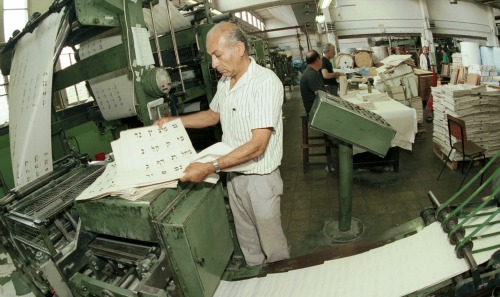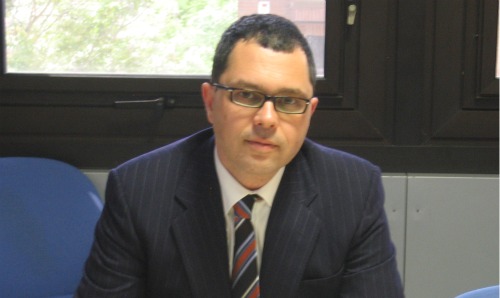Offices worldwide are slashing print costs with the help of green software developed by an Israeli company that reduces paper and ink use.

The first software in the world to receive an endorsement from the Global Eco-labeling Network (GEN) was developed by Preton, a Tel Aviv startup that provides print optimization software for business and home users.
Preton’s PretonSaver Enterprise and PretonSaver Premium software were awarded GEN’s “Green Label” last July for their part in reducing consumption of natural resources, promoting durability and recycling, and minimizing waste.
In September, bradham360, a leading independent lab analyst in the printing and imaging industry, dubbed Preton “the most recommended solution for saving money and going green.” Independent investigation verified the company’s claim of nearly 70 percent cost savings.
The patent-pending software optimizes the use of toner and ink and provides a printing management system.
Countering paper pollution
Printing costs are getting seductively lower all the time. This is a boon to voracious consumers, but a bust for overall printing costs (paper and cartridges) — and the environment.
Despite the onward thrust of the digital age, many large organizations still keep paper-based records that guzzle toner and ink. Paper demand alone is growing at the rate of 2.1 percent each year, and office printing is the second largest polluter in the West after transportation.

“The idea of developing print optimization software started off as a business idea,” Preton CEO Ori Eizenberg tells ISRAEL21c. “I called about 20 companies in different sectors and asked if they knew how much they were spending on printing. Printing is very expensive and yet most businesses did not have any idea how much they are spending. Many firms don’t even know how many printers they have.”
Eizenberg saw an opportunity. He had a strong background in business development and finance, having brokered $10 million worth of deals in two years while pitching for new markets in the Far East. Teaming up with colleagues Yishai Brafman and Boaz Katz, he founded Preton (“pre-ton”) in 2005.
A year later, Preton made Gartner’s “Cool Vendor” list. Despite the world economic crisis, or perhaps because of it, in tandem with increasing green legislation, the self-funded company sprinted ahead.
“We decided not to raise money and instead are grow organically. We only spend what we earn from sales,” says Eizenberg. “In the beginning, we were very hungry. We needed sales to cover our expenses.”
Revenues are growing in an upward trajectory. “The market is growing very rapidly. I am thrilled that we can save our clients tens of millions of dollars a year, and help to sustain the environment. It is a win/win for everyone,” says Eizenberg.
Pixel Optimizer
Computer pixels are square, while printer pixels are round. To compensate for the difference, the printer default system usually adds overlapping pixels, using more toner/ink than necessary. Preton CTO Brafman and his team developed Pixel Optimizer to delete unnecessary pixels in text, photos and other visuals before printing.
“We allow a ‘smear’ or ‘bleed’ effect to cover spaces left by removed pixels,” he says. Savings of toner/ink for text is 35 to 50%; for graphics, the saving is 18%; and for photos, 14%. Yet print quality remains high in both ink-jet and laser printers for corporate and home use.
Preton’s Elements Identifier is also key to cost savings. This technology identifies each element on a page – text, graphics, photos – and allows different levels of pixel reduction to be applied to each element type.
PretonSaver Enterprise gives management a total view and control of printing throughout the organization. It allows the enforcement of print policies, including a range of quotas, privileges and restrictions. “There is a saving as soon as the system is installed,” says Eizenberg.
Green savings embedded in software
It’s easy to calculate the green impact of PretonSaver for each customer, Eizenberg says, “because green savings are embedded in our software.”
“In general, we save one toner cartridge for every three employees every year. CO2 emissions from manufacturing a single toner cartridge equals 4.8 kilograms. That means we roughly save 4.8 kg for every three employees. In a global bank with 400,000 employees, that equals a savings of 624 tons of CO2 annually.”
One of Preton’s first customers, a healthcare service in the United Kingdom, estimates that in the UK, about 75 million cartridges each year go to landfills and only degrade after 450 years, presenting a risk to water supplies because they contain carcinogenic chemicals.
PretonSaver can also reduce the number of pages printed by 10% to 20%. For example, an average bank employee prints 10,000 sheets per year. There are 200,000 A4 sheets in a ton of paper (one tree). “We can save a ton of paper for every 200 employees,” Eizenberg says.
“Each ton emits 6.3 tons of CO2 during its manufacturing lifecycle. In the bank’s case, we can save 2,000 tons of paper, and reduce CO2 by 12,600 tons, saving one tree for every 10 employees.”
Users on four continents
Preton’s products have attracted hundreds of thousands of users on four continents. Samsung, the South Korean Air Force and South Korean Postal Services were among the company’s first clients. Others include Spain’s Social Security and Central Bank, the city of Rome, municipalities in the UK and the high-end jewelry manufacturer Tiffany. Telecom, IT services and educational institutions are also targets.
Preton entered the US market a year ago in the Environmental Protection Agency in Illinois, and will be implemented in 80% of the state’s other departments by the end of the year – a pattern the company’s managers hope to follow in other states. They are currently negotiating with a couple of health maintenance organizations and two large financial institutions.
Targeting the Far East as a strong market, Preton recently established offices in Tokyo and Hong Kong. PretonSaver software is in use at NTT, one of the largest telephone companies in Japan, as well as other major government departments in Japan and Hong Kong.
“We are not only focused on helping customers reduce operating expenses, we are also committed to facilitating green operations and environmental sustainability,” Eizenberg emphasizes.












